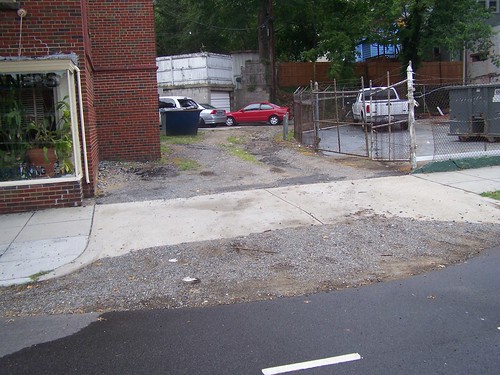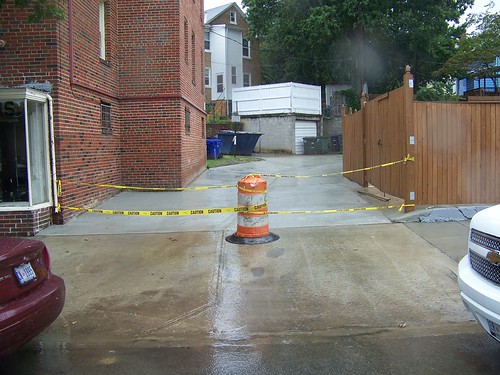Another example of DC Government's failure to engage in sustainability practice
A couple years ago, I contacted DC government through my Councilmember's Office and suggested that it be "repaved" to reduce runoff and stormwater runoff, and suggested that the treatment could be "green," in line with the city's Green Alleys Program, using pervious materials on the surface, so that more stormwater could be captured in site.
The response I got was that there wasn't money to do it.
Evidentally, the alley was put in the queue for reconstruction, because it is being reconstructed now, using standard concrete materials. So while it is an improvement simultaneiously it's an example of a failed opportunity to construct a "green alley" in terms of the alleged "green alley" program the city has.

Dirt/broken asphalt alley on the 6200 block of 3rd Street NW/200 block of Rittenhouse Street NW with serious run off problems.
The new alley is constructed of impervious concrete, and while dirt and gravel runoff will be eliminated, stormwater runoff will not be reduced, it will be increased, because at least the previous surface did capture some of the water before it ended up in the storm sewer system.

New alley being reconstructed presently.
Sadly, it's a demonstration that the Sustainable DC "plan" is mostly b.s., because city agencies don't seem to be changing their practices to be sustainable at all. (See the past blog entry "Realizing all aspects of Sustainable DC: it all comes down to chickens....")
What's the point of having a "Green Alley" program if you aren't going to (re)build green alleys?
What's the point of having a "Sustainable DC" plan if government agencies aren't going to adopt and execute sustainable practice?
-- "State, city experimenting with methods for curbing storm-water runoff," Baltimore Sun
-- "Once dreaded, D.C. alleys become fun, even chic," Washington Post, 2014
-- "Alley Homes Fight for Respect -- and Trash Pickup," Washington Post, 2006
Labels: alleys, government contracting, green-environment-urban, public finance and spending, sustainable land use and resource planning, transportation infrastructure, urban design/placemaking




10 Comments:
It boggles the mind that green alleys are not the norm. They should have been a decade ago. The money response is bs; DC has plenty of money, at least when it comes to tripling capacity on the SE Freeway and the 11th Street Bridges!
Is there any evidence that green alleys work?
I've noticed with tree boxes that runof looks about the same during heavy storms.
Well, in Seattle, they have some areas that capture close to 100% of the water.
I have seen video demonstrations of a green parking lot in Adrian Michigan that was pretty amazing.
I think it's all about execution.
Granted it requires a lot of underground reconstruction (as I learned pushing this idea in Baltimore County), but if you think of an alley pavement as having a 50 year or longer useful life, it pays off.
there is a problem with some green alley concepts in that they could allow standing water to accumulate and thus benefit mosquito populations. Ever since Gessfors Court was re-bricked- albeit with a concrete underlayer- the mosquito problems have diminished quite a bit. I would like to see a study of the impact green alleys have on decreasing this public health threat /as opposed to pure concrete or layered approcahes to alley resurfacing. This is also going to become a far worse problem as mosquitos and other dastardly critters make their way north with climate changes. Few people are considering or seem to be aware of these potential problems.
I don't see how pervious pavement would create the opportunity for standing water. At least in the demonstrations I've seen. But... that's based on the presumption that the underground is reconstructed to promote percolation.
If you need to work the baselayer, I could see green alleys being more expensive than throwing another slab of concrete down.
And 50+ years seems optimistic. They are getting truck traffic, albeit at slow speeds.
in Germany I have seen parking lots all over the old eastern cities where they just upend cinder blocks and the holes in the blocks have earth in them- you walk past one of these lots and you think you are in a field of grass or wheat- and then look down and its a pavement !! I have noot yet seen this here in the USA- it is extremely simple and likely a lot less expensive to make than these "green" treatments- at least from what I have seen. In Eisenach- the new Opal plant has this- as well as a fantastic array of green roofs.
charlie, you do make a useful point about my useful life calculation. A couple big heavy garbage trucks once/week do add up.
I did see some of the "upended" concrete blocks in the Ruhr, maybe in Marl?
Hopefully by the end of the week I'll produce a few articles about the Ruhr and Hamburg.
@RG; good examples, but again I ask do they work to reduce runnoff?
I see similiar tree boxes that are not doing the trick. Some rain that falls on them gets into the ground, but even a lot of that in heavy storms runs off. Annd it isnt' capturing runoff from the rest of the sidewalk.
I've notice in European cities that they use bags, not bins, or ask people to drop trash off at a central location. I'd suggested that we do the same for alley residents.
Wow, what an amazing giveaway !! Thanks so much
Post a Comment
<< Home